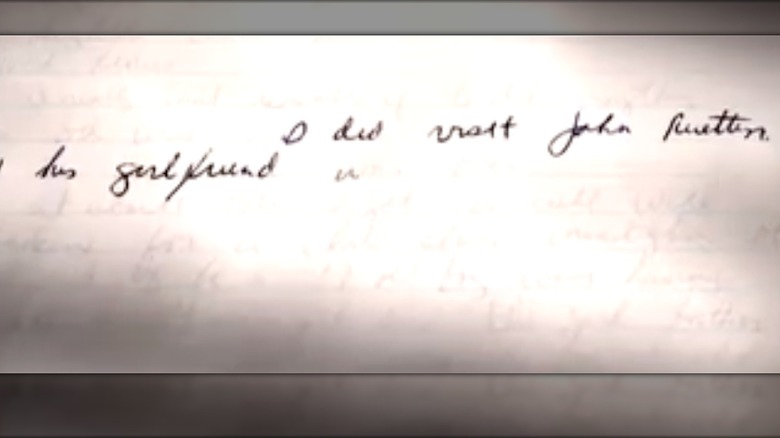Top 5 Most Disturbing Details About The Stephanie Lazarus Case
On the evening of February 24, 1986, John Ruetten returned from work to the Van Nuys, California condo he shared with his wife of three months, Sherri Rasmussen, a 29-year-old hospital nursing director. Inside, he found a shocking scene that spoke of horrific violence. In the living room, amid the remains of a broken vase and an overturned telephone, lay his wife. She had been badly beaten and shot three times in the chest.
The Los Angeles Police quickly determined Rasmussen had been the victim of a botched burglary. Someone had stacked electronics on the floor and the victim's BMW was missing. The investigation went nowhere. But 23 years later, when LAPD detectives reopened the cold case, they realized it was one of their own who'd committed the heinous murder. Stephanie Lazarus, a police detective for more than 20 years, had an on-again-off-again relationship with Ruetten and had killed her rival. She then used her police training to throw off investigators, one of the reasons it took so long to arrest Lazarus. She was caught when detectives connected DNA taken from a bite mark on the victim's arm to her.
The victim was bound, beaten, and shot
Sherri Rasmussen had suffered terribly before Stephanie Lazarus shot her three times at point-blank range using a thick robe to muffle the noise. There were ligature marks on Rasmussen's wrists and a cord found at the scene, indicating that Lazarus had tied her up at some point during the attack. Lazarus had also bludgeoned the victim's head. Among Rasmussen's other wounds were extensive facial injuries and a bite mark on her left forearm.
At the time, with forensic DNA technology just beginning, the arm wound didn't help investigators in their search for the killer, but more than 20 years later, it would become the linchpin to solving the murder. "Had it not been for DNA the case might not have been solved," Steve Cooley, the LA County DA at the time of Lazarus' arrest and conviction told the Associated Press in 2012. This was just one of hundreds of cold cases solved using DNA testing. Still, the original LAPD investigation suffered from much more than a lack of forensic technology. It was bungled from the start.
The LAPD overlooked obvious clues
From the outset, the LAPD, based on the crime scene, believed Sherri Rasmussen had come home in the midst of a burglary and was murdered as a result. This theory was later bolstered by an armed break-in in the same neighborhood involving two unidentified men, who police were unable to track down. But detectives ignored the pleas of Rasmussen's father, Nels, to look into Lazarus as a potential suspect (Lyle Mayer, the lead detective on the original case, later denied Nels had mentioned Lazarus to him).
Investigators also failed to interview witnesses who had seen Lazarus harassing Rasmussen at the hospital where she worked not long before her murder. Later, pieces of evidence and interviews with John Ruetten and Nels Rasmussen went missing from the police files. It didn't help the LAPD investigation that one of their own had been behind the crime and knew how to throw off suspicion by staging the scene to look like a burglary had taken place.
Lazarus used her police training to throw off suspicion
At the time of Sherri Rasmussen's murder, Stephanie Lazarus was an LAPD-beat cop but already knew enough about police work to throw detectives off her scent. At her trial, Mark Safarik, a former FBI criminal profiler, told the jury that the killer made the crime scene appear as if it had been a burglary that Rasmussen interrupted.
While on the surface, the electronics on the floor and Rasmussen's missing car did seem to point to the burglary theory, there were many other elements that didn't jibe with an actual burglary. No other rooms in the townhouse had been looted, the thieves hadn't filled the car with any valuables before stealing it, and the BMW wasn't stripped for parts. "What I saw was an attempt to create an illusion," Safarik said (via The Los Angeles Times). What had actually happened was a planned attack on Rasmussen by Lazarus, who was jealous that her former lover had chosen to marry someone else, according to prosecutors.
On and off again lovers
Stephanie Lazarus and John Ruetten first met during college at UCLA in the late 1970s and casually dated on and off for several years. Then, when Ruetten became engaged to Sherri Rasmussen, Lazarus became jealous. She and Ruetten slept together once after he'd become engaged to Rasmussen and Lazarus began to harass her rival at work, even bragging about having had sex with Ruetten to Rasmussen, according to Matthew McGough's "The Lazarus Files: A Cold Case Investigation."
Then, in 1989, three years after Rasmussen's murder, Ruetten and Lazarus reignited their relationship on a trip to Hawaii. Vanity Fair reported that he'd contacted Lyle Mayer, the lead detective in the original case, before the trip to make sure there was nothing tying Lazarus to the crime. Mayer said there wasn't. Ruetten was unknowingly having sex with his wife's killer. The two again drifted apart. Ruetten remarried and had a family. Lazarus went on to marry a fellow police officer, adopt a daughter, and rise through the ranks of the LAPD to become a detective specializing in art theft.
The bite mark that led to Lazarus' arrest
The evidence that finally tripped up Stephanie Lazarus came from the bite mark she'd left on Sherri Rasmussen's left arm. In 2005 Jennifer Francis from the cold case homicide unit looked at the case and realized the swab taken from a bite mark on Rasmussen's arm was missing. She tracked it down to a coroner's freezer and learned the bite came from a woman. Yet, when she brought it to her colleagues, they didn't think that was reason enough to reopen the case. Then in 2009, during another cold case review, different detectives decided that the fact that the bite came from a woman meant the case was worth revisiting.
The detectives were able to get a usable amount of DNA from traces of saliva taken from the wound that had been sitting in storage for more than 20 years. They also noticed that Lazarus was listed in the case files as a former girlfriend of Ruetten. After they began secretly investigating their co-worker, detectives recovered a straw and cup Lazarus had thrown away. The DNA matched and they arrested Lazarus in June 2009 at LAPD headquarters.
In 2012, following a five-week trial, a jury took less than a day to find Lazarus guilty of first-degree murder. A judge sentenced her to 27 years to life in prison. In November 2023, Lazarus finally admitted to killing Rasmussen, but didn't apologize to the victim's family and said she wasn't planning to kill Rasmussen when she went to the condo that day, per NBC News. Lazarus is currently serving her sentence at the California Institution for Women, in Corona. Initially set to be freed on parole in November 2023, a state parole panel later blocked her release. Her next parole hearing is tentatively set for February 2025.





